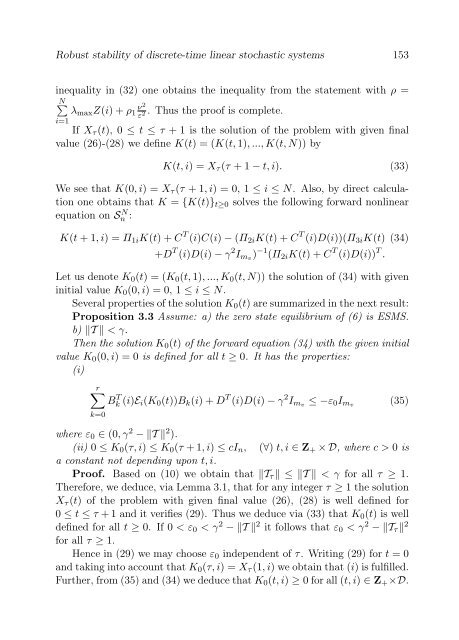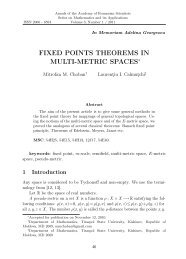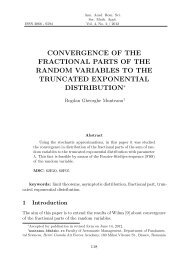152 Vasile Dragan, Toader Morozanhas a unique solution Z = (Z(1), Z(2), ..., Z(N)) ∈ S N+n . We recall thatunder the assumption a), if v ∈ l 2˜H{0, ∞; R mv } then, from Lemma 4.3 in [9],we have limt→∞E[|x(t, x 0 , v)| 2 ] = 0.Applying Lemma 2.1 in the special case F (t, i) = 0, X(t, i) = Z(i) <strong>and</strong>taking the limit for τ → ∞, one gets:˜J γ (∞, x 0 , v) =N∑∞∑π 0 (i)x T 0 Z(i)x 0 + E[v T (t)H γ (Z, η t )v(t) +i=1t=0+2x T (t, x 0 , v)N T (Z, η t )v(t)] (31)for all v ∈ l 2˜H{0, ∞; R mv } <strong>and</strong> all x 0 ∈ R n , where N(Z, i) <strong>and</strong> H γ (Z, i) areas in (16) <strong>and</strong> (17) with Z(i) instead of X γ F(t, i).Let ε be such that ‖T ‖ 2 < γ 2 − ε 2 . Thus we may write:˜J γ (∞, 0, v) = ‖T v‖ 2 l 2˜H{0,∞;R nz } − γ2 ‖v‖ 2 l 2˜H{0,∞;R mv } ≤ −ε2 ‖v‖ 2 l 2˜H{0,∞;R mv } .Therefore˜J γ (∞; x 0 , v) ≤orN∑∞∑π 0 (i)x T 0 Z(i)x 0 + E[2x T (t, x 0 , 0)N T (Z, η t )v(t)−ε 2 |v(t)| 2 ]i=1t=0˜J γ (∞; x 0 , v) ≤N∑λ max (Z(i))|x 0 | 2 + 1 ε 2i=1∞ ∑t=0E[|N(Z, η t )x(t, x 0 , 0)| 2 ]∞∑− E[|εv(t) − 1 ε N(Z, η t)x(t, x 0 , 0)| 2 ].t=0Let ν > 0 such that max|N(Z, i)| ≤ ν. Thus we have˜J γ (∞; x 0 , v) ≤N∑i=1λ max (Z(i))|x 0 | 2 + ν2ε 2∞ ∑t=0E[|x(t, x 0 , 0)| 2 ]. (32)From the assumption a) we deduce that there exists ρ 1 > 0 not dependingupon x 0 such that ∞ E[|x(t, x 0 , 0)| 2 ] ≤ ρ 1 |x 0 | 2 . Introducing the∑lastt=0
Robust stability of discrete-time linear stochastic systems 153inequality in (32) one obtains the inequality from the statement with ρ =N∑νλ max Z(i) + ρ 21 . Thus the proof is complete.ε 2i=1If X τ (t), 0 ≤ t ≤ τ + 1 is the solution of the problem with given finalvalue (26)-(28) we define K(t) = (K(t, 1), ..., K(t, N)) byK(t, i) = X τ (τ + 1 − t, i). (33)We see that K(0, i) = X τ (τ + 1, i) = 0, 1 ≤ i ≤ N. Also, by direct calculationone obtains that K = {K(t)} t≥0 solves the following forward nonlinearequation on S N n :K(t + 1, i) = Π 1i K(t) + C T (i)C(i) − (Π 2i K(t) + C T (i)D(i))(Π 3i K(t) (34)+D T (i)D(i) − γ 2 I mv ) −1 (Π 2i K(t) + C T (i)D(i)) T .Let us denote K 0 (t) = (K 0 (t, 1), ..., K 0 (t, N)) the solution of (34) with giveninitial value K 0 (0, i) = 0, 1 ≤ i ≤ N.Several properties of the solution K 0 (t) are summarized in the next result:Proposition 3.3 Assume: a) the zero state equilibrium of (6) is ESMS.b) ‖T ‖ < γ.Then the solution K 0 (t) of the forward equation (34) with the given initialvalue K 0 (0, i) = 0 is defined for all t ≥ 0. It has the properties:(i)r∑Bk T (i)E i(K 0 (t))B k (i) + D T (i)D(i) − γ 2 I mv ≤ −ε 0 I mv (35)k=0where ε 0 ∈ (0, γ 2 − ‖T ‖ 2 ).(ii) 0 ≤ K 0 (τ, i) ≤ K 0 (τ + 1, i) ≤ cI n , (∀) t, i ∈ Z + × D, where c > 0 isa constant not depending upon t, i.Proof. Based on (10) we obtain that ‖T τ ‖ ≤ ‖T ‖ < γ for all τ ≥ 1.Therefore, we deduce, via Lemma 3.1, that for any integer τ ≥ 1 the solutionX τ (t) of the problem with given final value (26), (28) is well defined for0 ≤ t ≤ τ + 1 <strong>and</strong> it verifies (29). Thus we deduce via (33) that K 0 (t) is welldefined for all t ≥ 0. If 0 < ε 0 < γ 2 − ‖T ‖ 2 it follows that ε 0 < γ 2 − ‖T τ ‖ 2for all τ ≥ 1.Hence in (29) we may choose ε 0 independent of τ. Writing (29) for t = 0<strong>and</strong> taking into account that K 0 (τ, i) = X τ (1, i) we obtain that (i) is fulfilled.Further, from (35) <strong>and</strong> (34) we deduce that K 0 (t, i) ≥ 0 for all (t, i) ∈ Z + ×D.
- Page 1: ACADEMY OF ROMANIAN SCIENTISTSANNAL
- Page 4 and 5: Annals of the Academyof Romanian Sc
- Page 7 and 8: Annals of the Academy of Romanian S
- Page 9 and 10: Concepts of dichotomy in Banach spa
- Page 11 and 12: Concepts of dichotomy in Banach spa
- Page 13 and 14: Concepts of dichotomy in Banach spa
- Page 15 and 16: Concepts of dichotomy in Banach spa
- Page 17 and 18: Concepts of dichotomy in Banach spa
- Page 19 and 20: Concepts of dichotomy in Banach spa
- Page 21 and 22: Concepts of dichotomy in Banach spa
- Page 23 and 24: Annals of the Academy of Romanian S
- Page 25 and 26: Robust stability of discrete-time l
- Page 27 and 28: Robust stability of discrete-time l
- Page 29 and 30: Robust stability of discrete-time l
- Page 32 and 33: 150 Vasile Dragan, Toader MorozanWe
- Page 36 and 37: 154 Vasile Dragan, Toader MorozanLe
- Page 38 and 39: 156 Vasile Dragan, Toader MorozanBe
- Page 40 and 41: 158 Vasile Dragan, Toader Morozanwh
- Page 42 and 43: 160 Vasile Dragan, Toader Morozan1
- Page 44 and 45: 162 Vasile Dragan, Toader Morozan(i
- Page 46 and 47: 164 Vasile Dragan, Toader MorozanWe
- Page 48 and 49: 166 Vasile Dragan, Toader Morozanth
- Page 50 and 51: 168 Vasile Dragan, Toader Morozan)w
- Page 52 and 53: 170 Vasile Dragan, Toader Morozan[1
- Page 54 and 55: 172 Peter Philipkeywords: nonlinear
- Page 56 and 57: 174 Peter PhilipΩ g,3Ω sΩ sΩ g,
- Page 58 and 59: 176 Peter Philipusing the nonlocal
- Page 60 and 61: 178 Peter Philipsuch that (3) becom
- Page 62 and 63: 180 Peter PhilipDenition 8. Assume
- Page 64 and 65: 182 Peter Philip(b) If f ∈ L 1 (
- Page 66 and 67: 184 Peter Philipare related to weak
- Page 68 and 69: 186 Peter Philip(A-18) ɛ : Σ −
- Page 70 and 71: 188 Peter Philipω s,1 ω s,1ω s,1
- Page 72 and 73: 190 Peter PhilipThe approximation o
- Page 74 and 75: 192 Peter Philipvector ⃗u := (θ
- Page 76 and 77: 194 Peter Philip4.4 The Finite Volu
- Page 78 and 79: 196 Peter PhilipGeometry Temperatur
- Page 80 and 81: 198 Peter Philipdirectly as in (28)
- Page 82 and 83: 200 Peter Philiptimized solutions s
- Page 84 and 85:
202 Peter Philip[16] P.-É. Druet a
- Page 86 and 87:
204 Peter PhilipProceedings of the
- Page 88 and 89:
206 Nicolae Cîndea, Marius Tucsnak
- Page 90 and 91:
208 Nicolae Cîndea, Marius Tucsnak
- Page 92 and 93:
210 Nicolae Cîndea, Marius Tucsnak
- Page 94 and 95:
212 Nicolae Cîndea, Marius Tucsnak
- Page 96 and 97:
214 Nicolae Cîndea, Marius Tucsnak
- Page 98 and 99:
216 Nicolae Cîndea, Marius Tucsnak
- Page 100 and 101:
218 Nicolae Cîndea, Marius Tucsnak
- Page 102 and 103:
220 Nicolae Cîndea, Marius Tucsnak
- Page 104 and 105:
Annals of the Academy of Romanian S
- Page 106 and 107:
224 Klaus Krumbiegel, Ira Neitzel,
- Page 108 and 109:
226 Klaus Krumbiegel, Ira Neitzel,
- Page 110 and 111:
228 Klaus Krumbiegel, Ira Neitzel,
- Page 112 and 113:
230 Klaus Krumbiegel, Ira Neitzel,
- Page 114 and 115:
232 Klaus Krumbiegel, Ira Neitzel,
- Page 117 and 118:
Sufficient optimality conditions fo
- Page 119 and 120:
Sufficient optimality conditions fo
- Page 121 and 122:
Sufficient optimality conditions fo
- Page 123 and 124:
Sufficient optimality conditions fo
- Page 125 and 126:
Sufficient optimality conditions fo
- Page 127 and 128:
Sufficient optimality conditions fo
- Page 129 and 130:
INFORMATION FOR AUTHORSSUBMITTING M






